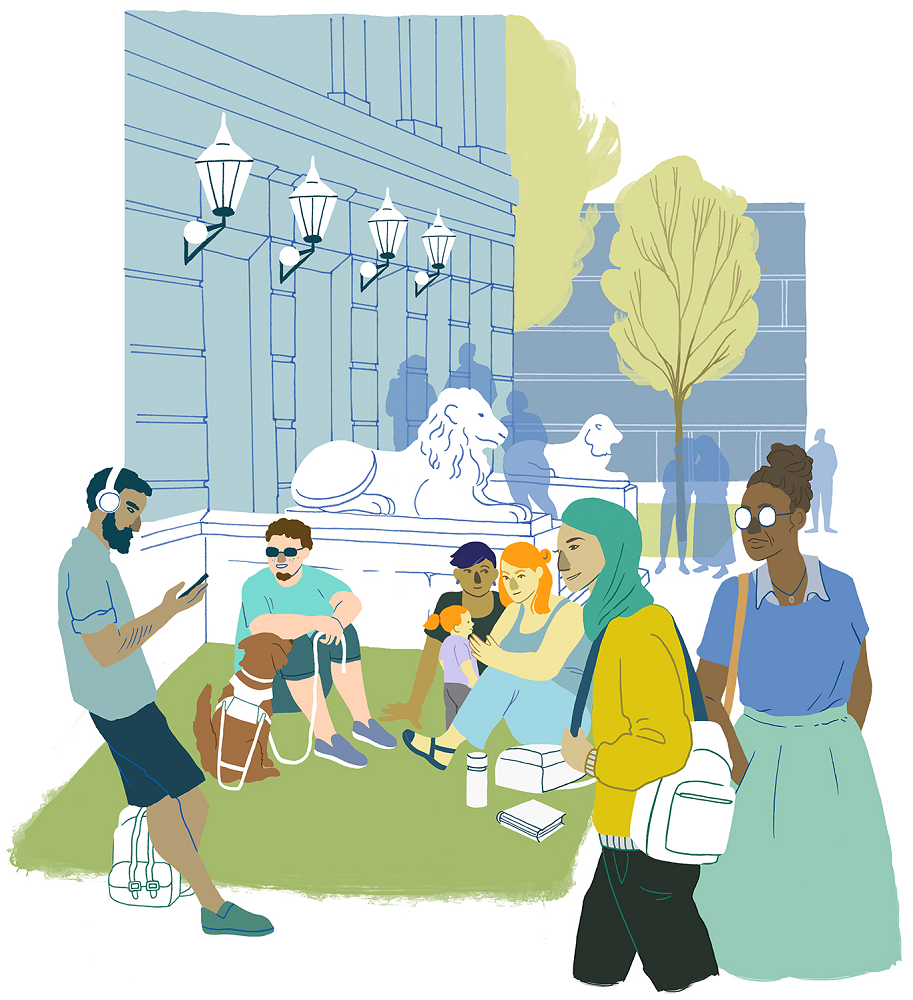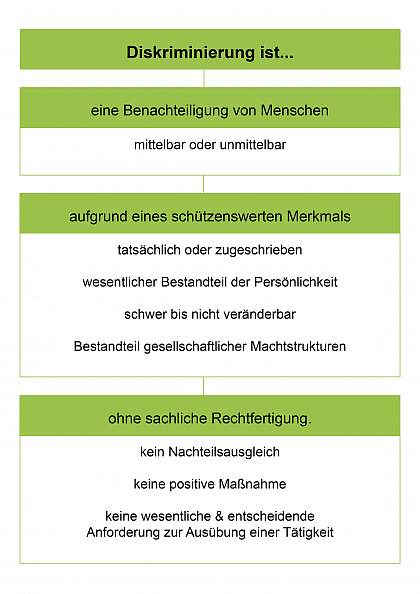
Links
What is discrimination?
Overview
What is discrimination?

Schaubild: Was ist Diskriminierung?
When asking what discrimination is, reference is often made to the General Equal Treatment Act (AGG for short). It is also colloquially referred to as the "Anti-Discrimination Act". However, the AGG itself does not use the term "discrimination" at all. It speaks of disadvantages to people on the basis of characteristics worthy of protection without objective justification. These are prohibited by law.
In order to define the term discrimination in sociological terms, the legal explanations of the AGG are a good guideline. However, there is another dimension that the AGG does not deal with in depth: Protective characteristics are part of societal power structures that have been established over centuries and are still very powerful in our society despite more intensive efforts for anti-discrimination. Discrimination is not only individual, but also structurally rooted: it requires a power structure that supports the disadvantage.
For example, from a sociological point of view, it makes a big difference whether a homosexual person claims that heterosexuality is a disease and needs to be treated, or whether a heterosexual person claims this about homosexuality. Both statements are disrespectful, offensive, and hurtful. Moreover, the heterosexual person's assertion is consistent with a centuries-old history of pathalogizing, oppressing, criminalizing, and murdering people because of their homosexuality, and there are still a frightening number of people who share this assertion. The homosexual person's statement, on the other hand, will not find much support - neither in the historical nor in the contemporary context - it lacks structural power. In order to distinguish between the two types of unjustified disadvantage, it is therefore argued that one should only speak of discrimination if the unjustified disadvantage is endowed with power on the basis of a characteristic worthy of protection and corresponds to an existing relationship of domination. According to this view, therefore, there can be no racial discrimination against white persons, for example, and no sexism against cisgender men.
In order to protect against discrimination and advocate for a culture of anti-discrimination, it is important to understand it from a social science perspective as well. Accordingly, direct discrimination is based on the assertion of differences between groups of people that are used to justify disadvantageous unequal treatment. The underlying mindset can be imagined as follows: The homogeneity of other groups is asserted ("They are all the same."), whereas one also considers oneself to belong to a group ("we"), but nevertheless also perceives oneself as an individual ("I"). The groups are contrasted in a polarizing way ("They are different from us") and arranged hierarchically ("We have more rights than they do"). This hierarchization is finally justified by supposed characteristics of the supposedly homogeneous group ("We must have more rights than they do, because they all have property XY"). One's own group is thus upgraded, the supposedly other group devalued, and the alleged difference used as a justification for unequal treatment. This makes the unequal treatment appear to be justified rather than unjust. Often, the attribution of supposedly natural and unchangeable characteristics is used.
Even if the distinctions that discrimination asserts need not be real, the consequences of discrimination for the persons affected are always something real. It is not just about isolated individual opinions or dislikes, but about fundamental resources and opportunities for social participation that are not open to all members of society on an equal basis. Discrimination is used to mark the boundary between the majority society and minorities, between "normal" and "deviant," and to ascribe negative characteristics to certain groups of people across the board in order to justify why they occupy disadvantaged social positions. The individual situation is neglected and the individual is seen only as a representative of a supposedly uniform social group. This can go so far that groups of people are denied their humanity altogether. In addition to hate crimes committed by individual perpetrators, this can also be done by larger institutions, e.g. discrimination was an element in the enslavement of people of African origin under colonialism or the murder of Jewish people, people with disabilities or other groups of people stigmatized as "degenerate" under National Socialism. Discrimination is not just a matter of individual insults or acts of violence, but a complex system of power in society as a whole with a long tradition that is still effective today and in which we are all interwoven.
What forms of discrimination exist?
Levels of discrimination
Discriminations can take place at various levels. For example:
| societal level (ideology) | ideological ideas, labels and images about normality and deviations transported in media and everyday conversations; representations; clichés; prejudices (e.g. idea of natural two genders and stigmatization of genders beyond it as sick and in need of treatment) |
| institutional level (institutionalization) | Discrimination as a result of the actions of organizations, companies and administrations due to laws, regulations, instructions, routines or corporate culture (e.g. forms that do not take into account all realities of life and act as gatekeepers) |
| interpersonal level (interactions) | one person discriminates against another for his or her own motives (e.g., one person racially insults another) |
| intrapersonal level (internalisation) | A person is self-deprecating due to discrimination ground (e.g. self doubt, self hate) |
Discrimination grounds
Discriminations differ with regard to characteristics to which they relate. At MLU, discriminations on the basis of the following protected characteristics – also stated in the General Equal Treatment Act (AGG) – are not allowed:
- ethnic background
- gender
- religion or ideology
- disabilities / special needs
- age
- sexual orientation
These characteristics relate to essential elements of one's personality and cannot be changed arbitrarily. Depending on the feature discriminations refer to, they can be differentiated terminologically. For example:
- A man is discriminated, because he is a Jew. (= anti semitism)
- A woman is discriminated, because she is a woman. (= sexism)
- A man is discriminated, because he is gay. (= homophobia)
- A woman is discriminated, because she sits in a wheelchair. (= ableism)
- A person is discriminated against because they have a non-binary gender identity (= transphobia).
- A man is discriminated against because he is Roman. (= anti-Romaism)
- A woman is discriminated against because she is Muslim. (= anti-Muslim racism).
It is irrelevant for a discrimination, if the characteristic is actual or just attributed. Therefore, it is also considered a racist discrimination, when a (discriminating) person assumes a so-called “migrant background”. When discriminations are based on a combination of characteristics, we are talking about multiple discrimination. For example:
- A female scientist is rejected for a job subsequent to her PhD, because it is assumed, that women of her age should have an urgent desire to have children and they have to be alert to a soon-to-be long-term withdrawal due to parental leave. (= discrimination on the basis of the characteristics gender and age)
Mediate and immediate discrimination
In addition, it can be distinguished between mediate and immediate discrimination. Mediate discrimination occurs, when a person is treated less favorably than another person. Short: same is treated different. For example:
- A foreign student conducts a presentation together with a German fellow student. The fellow student gets a much better grade than the foreign student does, even though their performances were equal.
Immediate discrimination occurs, if requirements seem to be neutral, but lead to a less favorably treatment of a particular group of people in practice. Short: Different (according to dissimilar conditions) is treated same. For example:
- A student cannot write as quick as her fellow students due to a disability, but has to take written exams within the same amount of time than everyone else.
At MLU mediate as well as immediate discriminations are not permitted.
Forms of discrimination
A broad spectrum of actions and structures can cause experiences of discrimination. This ranges from everyday small remarks, which in sum lead to a stressful discriminatory climate, to exclusions and barriers, to massive crimes such as assault and homicide. The following is an overview that shows the spectrum of possible experiences of discrimination:
- Prejudice:
Generalizations that attribute certain characteristics or behaviors to people based on group membership. These can be negative (e.g., "Foreigners are criminals.") or supposedly positive (e.g., "Gay men are always so creative!"). - Degradation:
Insulting, harassing, stigmatizing, excluding, patronizing, not taking seriously, ridiculing, belittling, infantalizing, exposing, disrespecting accomplishments, bullying, unequal pay, presenting as a pitiful victim - Microaggressions:
Everyday discrimination that repeatedly demonstrates that a person is different and does not belong. Many perceived small things add up to an overall hostile situation (e.g., when a person is repeatedly asked where they are really from because of their appearance). - Non-thematization:
No (positive) representation in media, lack of role models, not thinking about things. - Overemphasis:
Reduction to group membership, collusion of individuality, exoticization, fetishization, glorification. - Cultural appropriation:
Members of a dominant culture illegitimately appropriate for their own benefit elements of a culture that is oppressed by it, e.g., when white people adopt hairstyles from Black culture and are celebrated as "hip" & "trendy" for doing so, while Black persons straighten their hair or wear wigs because they otherwise don't have a good chance of getting a good job in a dominant white society. - Barriers to Access:
Exclusions and impediments to participation through failure to address needs: structural (e.g., no elevator, no accessible restroom, no all-gender restroom), linguistic (e.g., no interpreters, no multilingual texts, non-accessible documents), lack of family-friendliness (e.g., no childcare, no scheduling), lack of accessibility (e.g., no accessibility to the public). (e.g., no childcare), scheduling (e.g., not observing religious holidays), culinary (e.g., not offering foods that are allergy-friendly, kosher, or halal), or financial (e.g., admission prices that are not affordable for every person). - Violence:
Hate speech, threats, property damage, robbery, assault, performing non-emergency medical surgeries, sexual violence (e.g., coercion, rape), arson, explosives offenses, deprivation of liberty, displacement, persecution, enslavement, homicide, assassinations, genocides.
Can every disadvantage be understood as discrimination?
According to the AGG, disadvantages can also be justified in an objective way. In this case they cannot be understood as discrimination. Therefore, not every disadvantage is a discrimination.
An objective justification exists, when there is a support measure in compensation with a current disadvantage (“positive measure”) or the criteria for an unequal treatment for carrying-out a job is a significant and crucial requirement. For example:
- A counseling center for migrants searches in a job advertisement for advisory service for a person of a certain ethnic background, because it can be a significant requirement to develop important mutual trust for the consultation.
- A man without disability applies for a job at the university. Even though he is as qualified as his severely disabled competitor is, he does not get the position. This is not a discrimination.
Even though every disadvantage, insult or hurtful act can be unpleasant for the person concerned, not every conflict also constitutes a discrimination. Discrimination always refers to attributes worth protecting that are an essential element of the personality, not arbitrarily modifiable and an integral part of social power structures. For example:
- A student says about one of her fellow students: ”People, who listen to Heavy Metal music are anyway too stupid to study”. That is insulting, can hurt the student and can lead to an argument between the two of them, but music taste is not a protective feature and the statement of the student not a discrimination.




